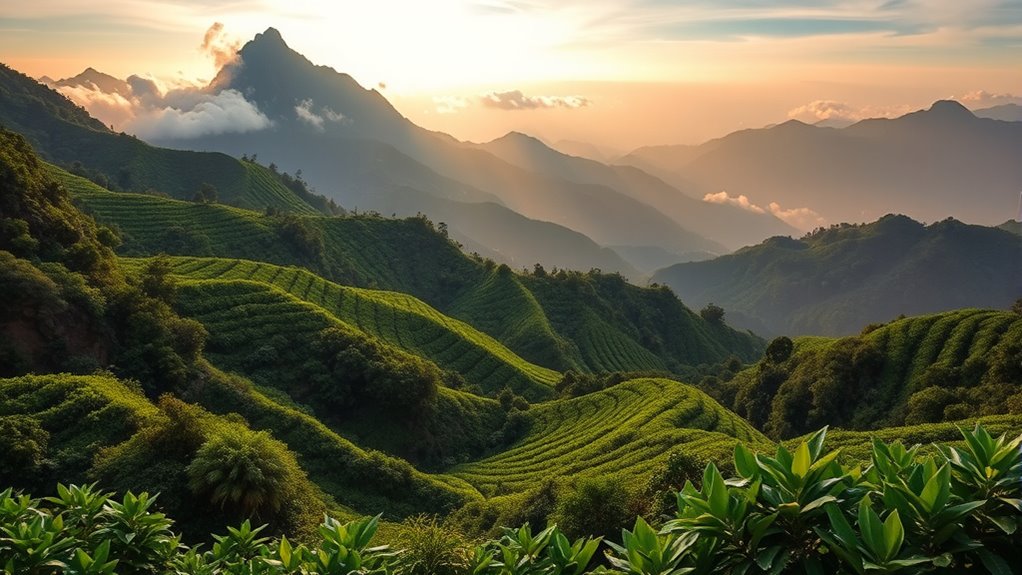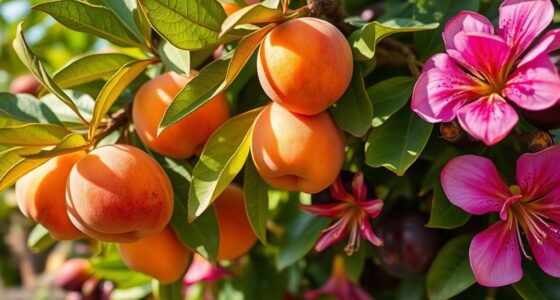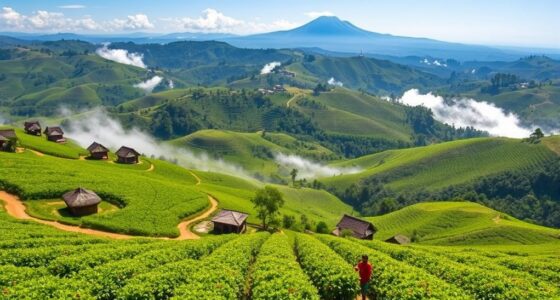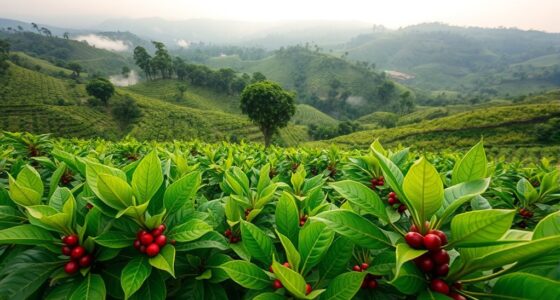High-altitude coffee grows in cooler, challenging conditions that slow cherry ripening. This extended development helps beans develop complex flavors and bright acidity, which create a richer taste experience. Proper harvesting and sustainable farming practices further enhance the quality, ensuring each cup is full of nuanced notes. If you want to understand how elevation and careful cultivation truly elevate coffee quality, keep exploring this fascinating connection.
Key Takeaways
- Higher elevations slow cherry ripening, allowing beans to develop more complex flavors.
- Cooler temperatures at high altitudes enhance acidity and flavor nuance.
- Elevated growing conditions promote better bean maturation, resulting in superior quality.
- The challenging environment encourages meticulous harvesting, preserving bean integrity.
- Sustainable farming practices at high altitudes support healthier land and richer coffee profiles.
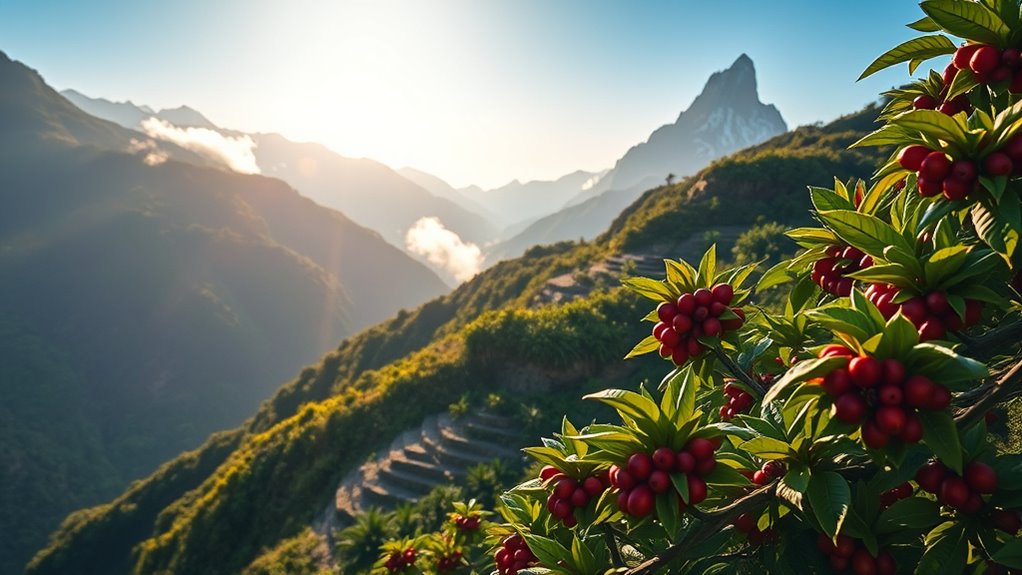
High-altitude coffee is prized for its unique flavor profile, which results from the challenging growing conditions found at higher elevations. When you grow coffee at these heights, the cooler temperatures slow the cherry’s ripening process, allowing the beans to develop more complex flavors and a brighter acidity. This natural process produces beans with nuanced taste notes that are highly sought after by connoisseurs. But it’s not just the environment that makes high-altitude coffee exceptional; the way farmers approach sustainability practices and harvesting techniques also plays a essential role in guaranteeing quality beans.
Sustainable farming practices are vital at high elevations because the delicate balance of the ecosystem can be easily disrupted. You’ll find that many high-altitude coffee growers prioritize soil conservation, use organic fertilizers, and implement water-saving techniques to protect the land for future harvests. These practices help maintain the health of the soil, which is essential for producing vibrant, flavorful beans. Additionally, farmers often adopt shade-grown methods, planting coffee under canopy trees that provide natural protection from the sun and help retain soil moisture. This approach not only benefits the environment but also encourages biodiversity, which contributes to the resilience of the coffee plants.
Harvesting techniques in high-altitude regions are equally important for quality. Because the cherries ripen more slowly, farmers usually harvest selectively, picking only the ripe cherries by hand. This labor-intensive process guarantees that unripe or overripe cherries don’t make it into the final product, which could compromise flavor and quality. As you might imagine, this meticulous approach requires skill and patience, but it’s worth the effort for the superior beans it produces. Farmers often work through multiple rounds of harvest to guarantee they’re gathering only the best cherries at peak ripeness. These careful harvesting techniques preserve the unique qualities that elevate high-altitude coffee, making every cup a rich, complex experience. Additionally, sustainable farming practices help ensure the long-term health of the land, supporting both quality and environmental stewardship.
In essence, the elevation creates the ideal conditions for developing extraordinary flavors, but it’s the growers’ sustainable practices and meticulous harvesting methods that truly open the potential of high-altitude coffee. By focusing on environmentally friendly techniques and precise picking, farmers not only protect their land but also produce beans that stand out for their depth and clarity. If you appreciate coffee with a story of careful cultivation and exceptional flavor, high-altitude beans are a proof of the dedication and skill of the farmers who grow them.
Frequently Asked Questions
How Does Altitude Affect Coffee Plant Growth Stages?
Altitude impacts coffee plant growth stages by enhancing photosynthesis efficiency, as cooler temperatures and increased sunlight optimize the process. You’ll notice leaf morphology changes, with smaller, thicker leaves that conserve water and adapt to the environment. At higher elevations, your coffee plants grow more slowly but develop complex flavors. This balance improves overall plant health and bean quality, making elevation a key factor in producing premium coffee beans.
What Specific Altitude Ranges Produce the Best Coffee Beans?
You’ll find that certain altitude ranges, typically between 1,200 and 2,000 meters, produce the best coffee beans. These ideal elevations provide cooler temperatures and better drainage, which enhance flavor development. At these elevations, coffee plants grow more slowly, allowing beans to develop complex aromas and acidity. So, if you’re seeking premium beans, look for coffees cultivated at these ideal elevations for the best flavor profile.
Are High-Altitude Coffees More Resistant to Pests and Diseases?
You might wonder if high-altitude coffees are more resistant to pests and diseases. Generally, the cooler temperatures and lower humidity at higher elevations reduce pest resistance and disease susceptibility. This environment creates a less favorable climate for many pests and pathogens, helping the coffee plants stay healthier. So, yes, high-altitude coffees often have better pest resistance and lower disease susceptibility, making them a more resilient choice for growers.
How Does Elevation Influence the Flavor Profile of Coffee?
Imagine elevation as a master chef, blending your coffee’s flavor profile with precision. You’ll notice higher altitudes heighten flavor complexity and acidity levels, like a symphony reaching new crescendos. The cooler temperatures slow bean development, allowing nuanced notes to flourish. As a result, you experience a brighter, more vibrant cup with lively acidity and intricate layers, making each sip a delightful journey through the mountain’s secret culinary artistry.
Can Low-Altitude Coffee Farming Ever Match High-Altitude Quality?
You might wonder if lowland coffee can match high-altitude quality. While altitude limitations affect flavor complexity, you can still uncover lowland coffee potential through innovative techniques like selective breeding, improved processing, and careful cultivation. Although low-altitude beans may not naturally develop the same vibrant acidity or nuanced flavors, your efforts can produce a unique, high-quality cup that appeals to diverse preferences, showcasing the versatility of coffee from different terrains.
Conclusion
So, next time you savor that perfectly brewed cup, remember it’s the lofty heights that made it special. Ironically, what’s often overlooked—elevation—might just be the secret ingredient you’ve been missing. While we chase exotic flavors and complex roasts, it’s the mountain air and cooler temps that truly elevate your coffee experience. So, here’s to high-altitude beans—proof that sometimes, the best things in life really do come from above.
